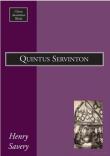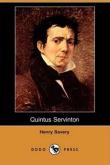AustLit
Latest Issues
AbstractHistoryArchive Description
'By setting, by date of publication, and the residence of the author, Quintus Servinton is rightly regarded as Australia's first novel. Printed in Hobart Town in three volumes, in 1830-1, and expressly intended for dispatch to England (where it was re-issued in London in 1832), only a few copies were reserved for sale in Tasmania. Of these, only three are known to survive, and the book has long been inaccessible to any but the most persistent of readers.'
'It presents an invaluable and fascinating picture - first of English provincial life and of contemporary business dealing, and then of convict life as experienced by an educated convict, a contrast and complement to the Ralph Rashleigh picture of the convict of humble birth and little or no education crushed by brutality and manual labour.'
'In his introduction, Cecil Hadgraft traces the author's own chequered career - an amazing sequence of misfortunes and miscalculations both before and after his twenty-four hour reprieve from the gallows, and particularly significant for the assessment and appreciation of a novel known to be largely autobiographical.' (Source: Online)
Notes
-
'The first novel to be written, printed and published in Australia' (E. Morris Miller, Australian Literature [1940], 595).
Contents
-
Biographical Introduction,
single work
criticism
biography
(p. ix-xxx)Hadgraft provides a detailed account of Henry Savery's life to demonstrate where Quintus Servinton converges on and diverges from the life of the author.
-
Biographical Introduction,
single work
criticism
biography
(p. vii-xxviii)Hadgraft provides a detailed account of Henry Savery's life to demonstrate where Quintus Servinton converges on and diverges from the life of the author.
Publication Details of Only Known VersionEarliest 2 Known Versions of
Works about this Work
-
Collecting the Criminal : Murder and Mayhem in Cultural Institutions
2018
single work
criticism
— Appears in: Australasian Journal of Popular Culture , 1 March vol. 7 no. 1 2018; (p. 41-58) -
Colonial Australian Detectives, Character Type and the Colonial Economy
2016
single work
criticism
— Appears in: New Directions in Popular Fiction : Genre, Distribution, Reproduction 2016; (p. 43-66)'Crime fiction started early in Australia, emerging out of the experiences of transportation and the convict system at the beginning of the nineteenth century. The first Australian (that is, locally published) novel is generally agreed to be Quintus Servinton (1832), written by Henry Savery, a convicted forger who was transported to Van Diemen’s Land (Tasmania) in 1825 and—convicted once more of forging financial documents—died as a prisoner in Port Arthur in 1842. Quintus Servinton is a kind of semi-autobiographical fantasy that imagines its entrepreneurial protagonist’s redemption: surviving his conviction and jail sentence in order to return to England with his beloved wife. We can note here that it does four important things in terms of the future of crime narratives in Australia. Firstly, it presents colonial Australia as a place already defined by an apparatus of policing, legal systems and governance, where ‘justice’ can at least potentially work to restore an individual’s status and liberty: for example, through convict emancipation. Secondly, it insists that the experience of incarceration and punishment is crucial to that character’s reintegration into respectable life: ‘the stains that had marked him’, we are told, ‘were removed by the discipline he had been made to endure’ (Savery, vol. 3, ch. XIII, n.p.). Thirdly, the novel ties the colonial economy to financial investment and growth on the one hand, and fraud or forgery on the other. These apparent opposites are folded together at the moment of settlement to the extent that the phrase ‘forging the colonial economy’ is a kind of potent double entendre. Prominent transported forgers included the colonial artists Thomas Whatling (transported 1791), Joseph Lycett (transported 1814), Thomas Wainewright (transported 1837) and of course Henry Savery himself. In Savery’s novel, Quintus Servinton is ‘thunderstruck’ when someone explains the conventional distinction between legitimate financial deals and forgeries: ‘You surely do not mean, Sir, it can be a forgery, to issue paper bearing the names of persons who never existed….If that be the case…many commercial men innocently issue forgeries every day of their lives’ (vol. 1, ch. III, n.p.). This takes us to the fourth point: that crime fiction in Australia is also about imposture, where characters do indeed adopt ‘the names of persons who never existed’. The mutability of colonial characters—the question of how real (authentic) or fictional (fraudulent) they might be, and the impacts this has socially and fiscally on the colonial scene—soon becomes a tremendous problem for emergent systems of policing and governance in Australia. As Janet C. Myers notes, ‘the linkage between emigration and crime forged through convict transportation continued to evoke anxieties….The atmosphere in which such anxieties were nurtured was one of rapid social mobility and shifting identities in the Antipodes’ (2009, p. 83).' (Introduction)
-
Our First Novel Goes Online
2015
single work
column
— Appears in: The Mercury , 9 July 2015; (p. 13) -
‘There’s a Dead Body in My Library’ : Crime Fiction Texts and the History of Libraries
2015
single work
criticism
— Appears in: The Australian Library Journal , vol. 64 no. 4 2015; (p. 288-300) 'Since the publication of Australia’s first crime novel in 1830, Australians have read crime fiction for entertainment, for the reassurance that wrongdoers will be punished, and to test their deductive skills against those of their favourite sleuth. The novels, short stories and plays within the crime fiction genre that have been produced in Australia between colonial times and the present day also offer opportunities to investigate a particular place or a particular time. Indeed, many crime fiction writers have mastered the art of recreating settings in both rural and metropolitan landscapes. The details provided within these works ultimately reveal a culprit (usually a murderer), yet they also outline the availability of certain products, bus and train timetables, the floor plans of local hotels or world-famous buildings and numerous other particulars, thus providing a rich, if surprising, source of material for the merely curious and the professional researcher. Crime fiction stories set within libraries present a history of the information services profession. This paper demonstrates how crime fiction can provide an important supplement to more traditional historical sources, with a focus on how the genre has documented some of the major changes within libraries over the last 75 years, since 1939.' (Publication abstract) -
When Earth Cries Out : Telling Workers' Struggles
2013
single work
criticism
— Appears in: Telling Stories : Australian Life and Literature 1935–2012 2013; (p. 133-138)
-
Untitled
1963
single work
review
— Appears in: Quadrant , Autumn vol. 7 no. 2 1963; (p. 77-79)
— Review of Quintus Servinton : A Tale, Founded upon Incidents of Real Occurrence 1830-1831 single work novel -
Untitled
1963
single work
review
— Appears in: Australian Literary Studies , June vol. 1 no. 1 1963; (p. 70-72)
— Review of Quintus Servinton : A Tale, Founded upon Incidents of Real Occurrence 1830-1831 single work novel -
Apologia of a Convict-Gent
1963
single work
review
— Appears in: Australian Book Review , February vol. 2 no. 4 1963; (p. 59)
— Review of Quintus Servinton : A Tale, Founded upon Incidents of Real Occurrence 1830-1831 single work novel -
The Sensitive Convict
1963
single work
review
— Appears in: The Bulletin , 5 January vol. 85 no. 4324 1963; (p. 38-39)
— Review of Quintus Servinton : A Tale, Founded upon Incidents of Real Occurrence 1830-1831 single work novel -
Old Lag Wins Out
1984
single work
review
— Appears in: The Sydney Morning Herald , 15 September 1984; (p. 47)
— Review of Quintus Servinton : A Tale, Founded upon Incidents of Real Occurrence 1830-1831 single work novel -
Out of England : Literary Subjectivity in the Australian Colonies, 1788-1867
2004
single work
criticism
— Appears in: Imagining Australia : Literature and Culture in the New New World 2004; (p. 3-21) Modern Australian Criticism and Theory 2010; (p. 61-72) '...During traces the formation and transformation of 'modern literary subjectivity' in the distinctive conditions of nineteenth century Australia.' Source: Modern Australian Criticism and Theory (2010) -
Crime Scenes : The Importance of Place in Australian Crime Fiction
2010
single work
criticism
— Appears in: Journeying and Journalling : Creative and Critical Meditations on Travel Writing 2010; (p. 204-213) 'There are eight million stories about crime fiction. And this is one of them. There are two main ways in which writers use place in crime fiction. The first way is to use place to help create a certain mood and atmosphere. The second way is to use the geographical or physical features of a place imaginatively as a plot device. Sometimes the journeys that are made by characters in crime fiction serve to remind us as readers of these two major devices. Although historically a lot of Australian crime fiction has not focused on place in terms of setting, this is changing as Australia continues to change. (Author's introduction, 204)
-
Rediscovering Tasmanian Short Stories
2012
single work
criticism
— Appears in: Island , Spring no. 130 2012; (p. 34-39) 'In September, Text Publishing brought out Deep South: Stories from Tasmania, a collection of twenty-four Tasmanian stories that I co-edited with Danielle Wood. Our book is a calculated attempt to influence what people read: to persuade both Tasmanians and visitors alike to read some of the stories that have come out of the island over the last two centuries. It is, to draw on Michael Heyward's critique of the neglect of Australian literature more generally, an effort to curate Tasmania's literary history - or at least a part of it. And that's a start.' (Author's introduction)
-
Henry Savery (1791-1842)
Margaret Giordano
,
Don Norman
,
1984
single work
biography
— Appears in: Tasmanian Literary Landmarks 1984; (p. 9-16) -
Settlers, Convicts and Early Narrative
Joseph Jones
,
Johanna Jones
,
1983
single work
criticism
— Appears in: Australian Fiction 1983; (p. 1-7)
-
London,
cEngland,ccUnited Kingdom (UK),cWestern Europe, Europe,
- Tasmania,





